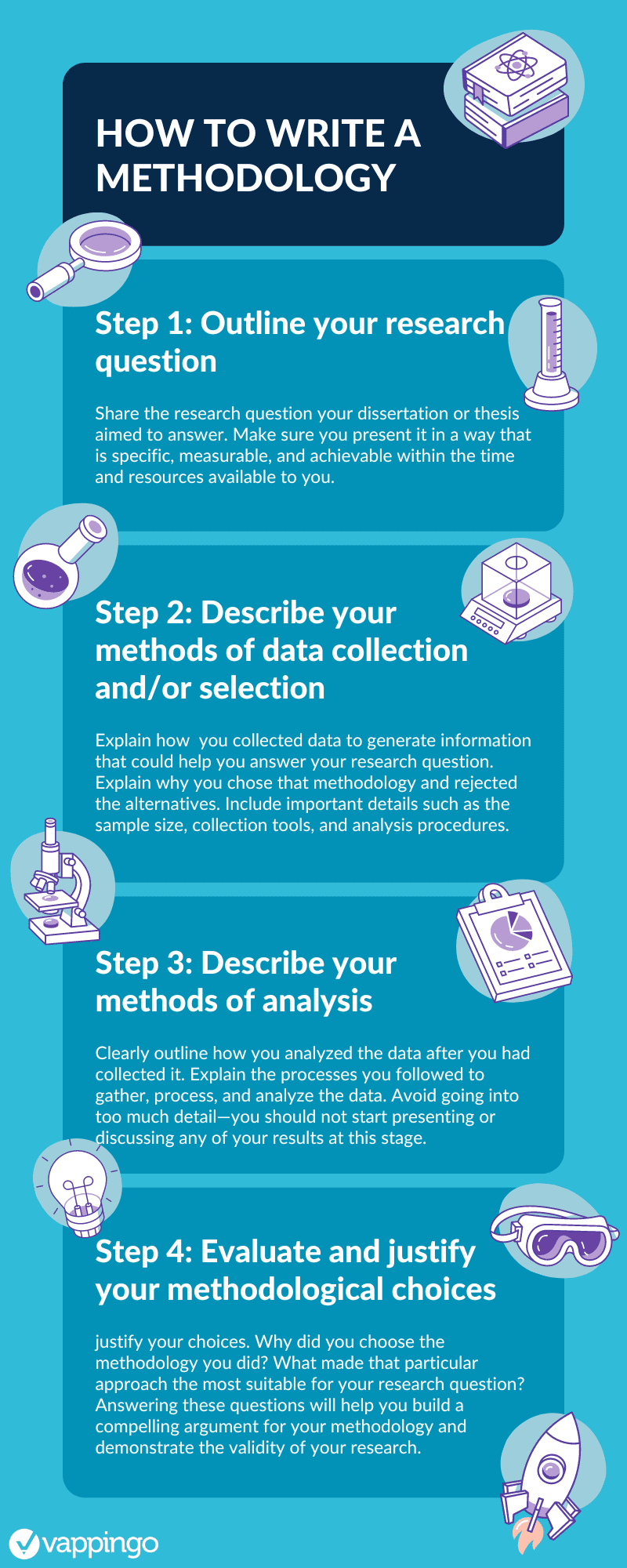This guide to how to write methodologies will tell you everything you need to know to nail the methodology section of your dissertation or thesis and set you on the right path to impress the review panel.
Before we dive into the specifics of what information should be included in methodologies, let’s have a quick recap on the overall structure of a thesis or dissertation. If you’re unsure of the difference between the two, read our guide to what is a dissertation.
Sections in a Thesis or Dissertation
In our guide to the thesis structure, we described how dissertations and theses are typically divided into six sections:

- Introduction: Introduces the topic of the research and contextualizes your study within the broader field of research. You may explain why your dissertation or thesis is valuable to your area of interest. See our guide to dissertation introduction mistakes for more assistance. You may also benefit from taking a look at our examples of great dissertation topics.
- Literature Review: Presents an in-depth examination of the existing literature related to your research topic, highlighting key findings and any gap in the literature that your study aims to address.
- Methodology: Outlines the research methods employed in your study and the associated data collection and analysis processes. Take a look at our guide to how to write a methodology for a dissertation to learn more.
- Results: Presents the research findings.
- Discussion: Explores how the research findings relate to your research question and plug any existing gaps in understanding.
- Conclusion: Summarizes your dissertation or thesis findings and how it answers the main research question. Shares reflections on the overall research process together with recommendations for future research.
After writing your dissertation, seek out the services of professional dissertation proofreading providers to ensure your final paper is free of any errors.
In this article, we are going to focus specifically on one of these sections: The methodology.
What are Methodologies?
The methodology is the process you’ll use to collect and analyze data for your research. It’s like a roadmap for your dissertation or thesis research, guiding you from start to finish.
This is where it gets complicated. You can choose from several different methodologies to guide your research. However, we can broadly divide methodologies into three types: qualitative, quantitative, and mixed methods.
Let’s take a look at each of these in turn.
Qualitative Research Methods
Qualitative methodologies focus on collecting non-numerical data; for instance, opinions, processes, experiences, perspectives, and attitudes. They can involve a range of methods, including interviews, focus groups, and observations.
Quantitative Research Methods
Quantitative methodologies involve collecting numerical data through questionnaires, surveys, experiments, and other forms of data collection. If you have engaged in research that involves statistical analyses and hypotheses testing, this is the approach for you.
Mixed Methods Research
As the name suggests, mixed methods research combines quantitative and qualitative approaches. This methodology can provide a more comprehensive understanding of a research topic, as it combines the depth of qualitative data with the statistical power of quantitative data.
When choosing a methodology for your dissertation or thesis, it’s important to consider your research question and the type of data you’ll need to collect to answer that question. You should also keep in mind the resources that are available to you, such as time, budget, and access to participants.
Why are Methodologies Important?
The methodology section of your dissertation or thesis gives you the chance to discuss your research methods and how they helped you respond to the research question. Methodologies are also great for demonstrating that your research was carefully executed and can be replicated.
The methodology establishes the credibility of your study, places it within the context of your field, and gives your readers a good insight into the process you followed.
How to Write Methodologies for Dissertations and Theses
You can write your dissertation or thesis methodology in four simple steps.

Step 1: Explain your research question
The first step in writing a methodology section is to share the research question your dissertation or thesis aimed to answer. This question should have guided your entire research project; as such, you should already be very clear as to what your research question is. Make sure you present it in a way that is specific, measurable, and achievable within the time and resources available to you.
See our guide to how to write a research question for more assistance.
Step 2: Describe your methods of data collection and/or selection
Having outlined the research question, explain the data collection process you engaged in to generate information that could help you answer it. What research approach did you adopt? Qualitative? Quantitative? Mixed? Explain why you chose that methodology and rejected the alternatives.
How did the approach you took make the most sense for your research?
Include important details such as the sample size, data collection tools, and analysis procedures. Be as specific as possible and make sure your methods were aligned with your research question.
Step 3: Describe your methods of analysis
Next, you should clearly outline how you analyzed the data after you had collected it. Take note! This section of your methodology is not concerned with presenting or discussing your data or findings.
The aim here is to explain the processes you followed to gather, process, and analyze the data. Avoid going into too much detail—you should not start presenting or discussing any of your results at this stage.
Step 4: Evaluate and justify your methodological choices
The final step in writing methodologies is to justify your choices.
Why did you choose the methodology you did? What made that particular approach the most suitable for your research question?
Answering these questions will help you build a compelling argument for your methodology and demonstrate the validity of your research. This puts you in a great position from which you can progress to present your research findings.
What Tense Should Research Methodologies be Written In?
According to the majority of style guides–for example, the APA rules–the research methodology section of your dissertation or thesis should be written in the past tense because it describes judgements and work you have already completed.
However, you should always check the specifics of the academic style guide you are following; for example, the MLA style guide.
Things to Avoid When Writing Methodologies
Including Irrelevant Information
The methodology of your thesis or dissertation should be in-depth but concise. Don’t include any background material when writing methodologies unless it clearly helps the reader to understand the rationale behind the approach you have chosen, the methods used to collect or obtain the data, and the process and tools you used to analyze it.
Going Into Too Much Detail About Simple Procedures
Keep in mind that you are not creating a how-to manual for the methodology you have chosen. You shouldn’t go into great detail about specific methodological approaches. Rather, assume that the readers have a fundamental understanding of academic research processes. Highlight how you applied the method rather than the nitty-gritty of how you executed it.
An exception though: If you choose an unconventional approach to the procedure, this guideline may not apply. You may need to explain why this method was chosen and how it improves the overall research process.
Problem Blindness
You almost certainly will run into issues while gathering or manipulating your data. Do not dismiss or deny these issues ever happened. An intriguing component of the process is detailing how you overcame the challenges you inevitably encountered. It shows the reader that you can offer a convincing justification for the choices you made to reduce the negative impacts of any issues you came across.
Failing to Include Citations
Make sure you cite any sources that influenced the development of your methodology. Yes, this section of the paper is not a literature review. However, you should be open about how your decisions to pursue certain methodologies were guided by the work of others. For instance, you may have developed a survey that built upon an existing instrument or a prominent theory may have informed your questionnaire. When writing your methodology, make sure you clearly inform the reader about your sources of inspiration.

